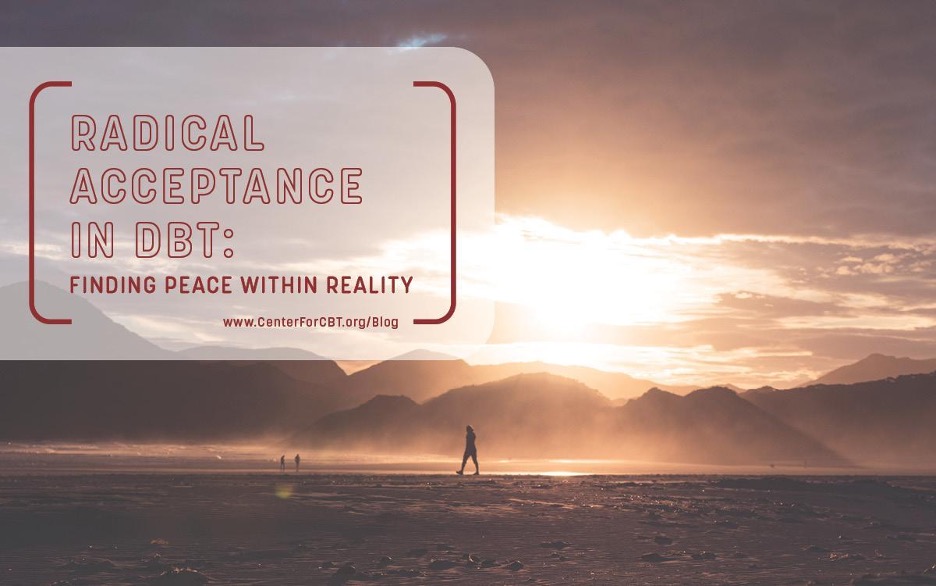We have all endured challenging and emotionally painful experiences at some point during our life. Unfortunately, some of life’s problems cannot be easily solved. This can be difficult to tolerate, and our feelings of distress can be amplified by oppositional patterns of thought. As a result, we may inadvertently intensify our feelings of unease and become emotionally dysregulated. However, by practicing DBT distress tolerance skills like Radical Acceptance, we can manage the emotional pain we feel and prevent it from becoming too overwhelming.
Changing Thought Patterns with the DBT Skills of Radical Acceptance
During stressful situations, high emotions are often coupled with thoughts like “It’s not fair” or “It shouldn’t be this way.” These rigid thoughts can manifest in response to big problems, like the loss of a loved one, or even in response to smaller challenges, like getting a dent in your car. In any type of challenging situation, thoughts like this can give us a clue that we are fighting our current reality. When we are not able to accept our reality, our already painful feelings can devolve into feelings of suffering. This intensified state of emotional distress can make it even more difficult for us to cope with any challenging situation.
We can reframe our outlook on a painful experience by practicing Radical Acceptance. The philosophy behind this DBT distress tolerance skill is to accept our situation exactly as it is in the moment. This is meant to be practiced wholly and fully, within our mind, body, and spirit. Radical Acceptance does not mean that you approve of, agree with, or even like a particular situation or the current state of your life. This skill is about making peace with reality as it is and accepting things the way that they are. It’s a decision to stop fighting what you cannot control, which will allow yourself the freedom to move forward, heal, and reach your goals.

Mastering DBT’s Radical Acceptance Skill: A Comprehensive Overview
Consider the following example to help you learn how to practice Radical Acceptance. Let’s say that you planned a vacation to the beach for a week. Once you get there it ends up raining for more days than none. It turns out that you will hardly be able to spend any time on the warm, sunny beach you had been looking forward to enjoying. Since you can’t change the weather to make it stop raining, what options do you have?
1. Mourn your lost plans. You could choose to focus on how disappointing it is that your plans have been rained out. As a result, you would probably feel bored and miserable. You might make the problem worse by constantly complaining about the situation. Maybe you would even go so far as to pack up the car and cut your trip short.
2. Make new plans. You could choose to make the most of the situation and find new activities that accommodate the weather. You may decide to walk and play in the rain despite your feelings of disappointment. You could also discover new indoor places and events. Or you could engage in some enjoyable indoor activities, like playing a board game or watching a movie, and just enjoy some downtime.
If you choose Option B, you would be radically accepting your situation. This choice enables you to engage in alternative activities that still allow you to enjoy your vacation, even though it wasn’t what you had originally intended. This type of approach can mitigate the feelings of intense anger, frustration, or sadness that you would likely experience if you only focused on the loss of your original plan. Choosing Option B does not mean that you are pleased with the weather— we are allowed to be upset when situations don’t go as expected. But fully participating in new plans means that you have accepted your reality and are striving to make the best of the situation.
A Step-by-Step Guide to Practicing the DBT Radical Acceptance Skill
Radical Acceptance is no easy feat. Like all DBT skills, success can be found with practice, consistency, and patience over an extended period. To begin practicing Radical Acceptance, follow this step-by-step guide:
1. Use Mindfulness. You can use the Mindfulness skill to observe when you are fighting or questioning reality through unhelpful thought patterns. You can also be aware of your body sensations, and when feelings of disappointment, sadness, or grief arise within you.
2. Accept things as they are. Remind yourself that an unpleasant reality just “is what it is” and cannot be changed. Acknowledge that life can be worth living even when there is pain.
3. Acknowledge how things happened. Remind yourself that there are causes for the reality you are currently living. Understand that a history of events has led to the current moment, and that everyone’s life has been shaped by a series of factors. Because of everything that led up to this moment, this reality occurred in just this way.
4. Involve your whole self. Practice accepting your mind, body, and spirit. You can do this through accepting self-talk, breathing and relaxation techniques, and somatic techniques like half-smiling and willing hands. Try this approach in a safe, relaxing space to help make it easier to think about your struggles.
5. Practice Opposite Action. List all the behaviors you would do if you did accept the facts, act as if you have already accepted the facts, and then engage in the behaviors that you would do if you really had accepted the situation.
6. Cope Ahead. With your mind’s eye, rehearse what you would do if you did accept what seems unacceptable.
7. Consider the pros and cons. If you find yourself resisting these acceptance practices, make a simple list of the pros and cons of your situation.

Accepting reality can be extremely difficult, especially when trying to cope with life-changing and traumatic events. Even those who are very experienced in practicing and applying skills from their DBT toolkit may struggle with this concept at times. No matter where you are in your mental health and wellness journey, it’s important to remember that you may need to “turn your mind” towards acceptance repeatedly. When you notice you’re fighting reality, remind yourself of these Radical Acceptance steps to help yourself cope with the situation at hand. Ultimately, your success in accepting reality and reducing your feelings of suffering comes down to your willingness to practice this skill. Even when faced with a painful life challenge, the practice of Radical Acceptance can provide you emotional relief and the freedom to move forward.


